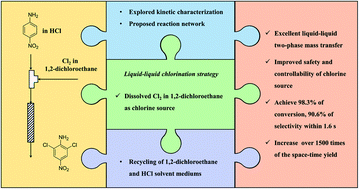An intensified chlorination process of 4-nitroaniline in a liquid–liquid microflow system†
Abstract
A strategy of dissolving chlorine gas in 1,2-dichloroethane as the chlorine source for a liquid–liquid two-phase chlorination reaction was proposed in this study to resolve the problems of low efficiency, strong corrosivity, and poor controllability of traditional gas–liquid chlorination. Taking the chlorination reaction of 4-nitroaniline to synthesize 2,6-dichloro-4-nitroaniline as an example, the feasibility of the liquid–liquid chlorination method was verified in a microflow system. It can achieve 98.3% conversion and 90.6% selectivity within 1.6 s under the optimized reaction conditions. The recycling of HCl and 1,2-dichloroethane solvents was facile, and after three runs of recycling the chlorination reaction can still maintain good conversion and selectivity. The influence of feed mixing and the reaction networks on chlorination of 4-nitroaniline were also explored as a guide for process design. Compared with the traditional gas–liquid chlorination, the reaction efficiency of liquid–liquid two-phase chlorination is greatly improved, and it has a prospect for industrial application in terms of safety and controllability.



 Please wait while we load your content...
Please wait while we load your content...